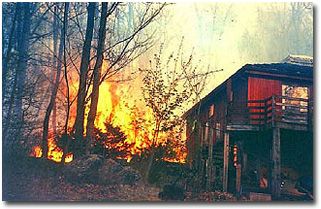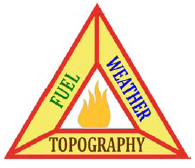Learn the Facts About Fire Behavior in Maryland
Wildfire Statistics
Wildfires are a common occurrence in Maryland. In an average year, the Maryland Forest Service responds to an average of 123 wildfires that burn more than 1,780 acres of forest, brush, and grasses. Fire departments respond to over 5,000 wildfire incidents per year.
While some wildfires in Maryland can burn hundreds or even thousands of acres, most are smaller in size, burning less than 10 acres. Even these smaller wildfires can threaten lives, homes, other structures, and our natural resources. Each year hundreds of homes and structures are threatened, and dozens are damaged or destroyed by wildfires.
Fire Season
Wildfires occur in every month in
Maryland, but peak in the spring and fall.
During these seasons the leaves are off
the deciduous trees, allowing sunlight
and wind to reach the forest floor and
dry the forest fuels. The relative
humidity of the air is also drier and,
combined with a breeze, creates the
conditions for wildfires to spread rapidly.
Wildfire Causes

The only natural cause of wildfires is lightning, and this accounts for only 4% of the wildfire ignitions in Maryland. The remaining 96% of wildfires are caused by humans. Maryland’s leading cause of wildfires is improper debris or outdoor burning that ignites an average of 35% of the fires each year. Arson, the second leading cause, accounts for around 30% of ignitions. Other causes include: equipment use, children playing with fire, smoking, campfires, railroads, and other miscellaneous ignitions from sources such as downed power lines, discarded ashes, and fireworks.
The Wildland-Urban Interface
A wildfire is an even greater
challenge when it threatens homes and
other structures. The zone where homes
are built in or near the forest is called the
Wildland-Urban Interface (WUI). The
number of homes built in the WUI in
Maryland has increased dramatically in
recent years.
Since 96% of wildfires are caused
by people, wildfire ignitions are also
more common in these Wildland-Urban
Interface zones. Considering all factors,
wildfires can be a significant threat in
Maryland. Homes and other structures
intermixed with wildland fuels are at
risk, and WUI residents need to take
actions to protect themselves and their
property.
Fire Behavior
Most wildfires in Maryland are
surface fires, which burn fallen leaves,
twigs, and debris on the ground. Under
this fallen debris is often a layer of
partially decomposed leaves and humus,
called “duff.” During dry periods, fires
can burn underground in this duff layer,
and be very difficult to extinguish. These
duff fires can burn for weeks, or even
months, and cause smoke issues.

The intensity of wildfires increases
greatly in areas of dense fine fuels, such
as grasses, or dense resinous fuels, such
as mountain laurel shrubs or evergreen
trees.

In these areas, wildfires can spread rapidly and burn with amazing
intensity. Maryland rarely experiences active crown fires - wildfires
that burn in the tree canopy. However, crown fires
can occur in dense stands of evergreen
trees during times of very dry and windy
weather.
The Wildfire Behavior Triangle
The three factors that control
wildfire behavior are fuels, weather, and
topography. In all fuel types the intensity
and rate-of-spread of a fire will increase
as slope increases, wind increases, and
relative humidity decreases.
Prescribed Fire
Prescribed fires, or fires ignited
under controlled conditions by fire
professionals, can be beneficial to reduce
forest fuels, improve wildlife habitat, and
prepare sites for tree planting.
For more information on the Wildland Fire Program, call 410-260-8503
or contact your local Forest Service Office.
 Download page a printable brochure
Download page a printable brochure